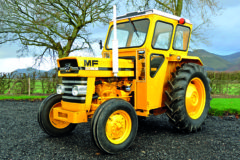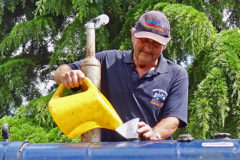A 1950s military Jeep
Posted by Chris Graham on 22nd June 2021
Timothy Slawson had a deep desire to own a 1950s military Jeep, and eventually did. This is his story about that vehicle and its restoration.

A 1950s military Jeep: Whenever I bring the Jeep out for an event or to drive, I often take photos of it before putting it back into storage. Sometimes I catch a nice photo while standing on my truck bed.
My desire to own a military jeep was based upon a variety of personal factors. I worked very hard at running a successful business, and never really had the time to enjoy a hobby. A local military history group in the Florida Keys would have vehicles available for local parades and events in South Florida. The Homestead Air Reserve Base (formerly the Homestead Air Force Base) a key strategic US Air Force base during the Cuban Missile Crisis, had annual events to pay tribute to its local military veterans. I saw several restored, Second World War military jeeps in the mix of vehicles, and knew I had to have one.
The search begins
So, I joined a local military vehicle club, The Monroe Marauders, without owning a vehicle. And a few other key elements played a hand in my vehicle selection. My grandfather served in the Korean War, while father served during the Cold War period, as a security officer in the US Air Force. He was stationed at Homestead Air Force Base during the Cuban Missile Crisis. So, a Korean War, 1950s-era jeep attracted me the most. To my wife’s surprise, I finally got the nerve to purchase one of my own.
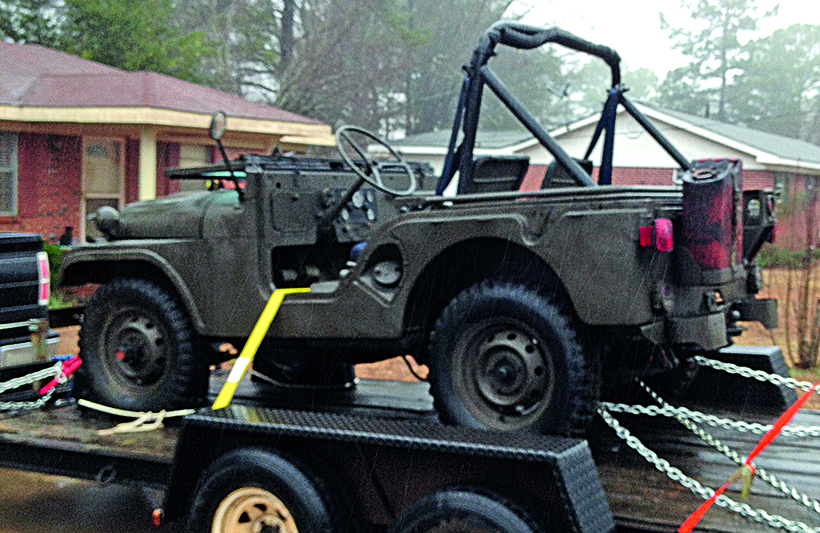
This was the original condition of the Jeep once we finally got it safely back to my grandmother’s house in Alabama. It had been a long, adventurous, wet and muddy day!
I saw the M38A1 and put down a deposit. The jeep was located not too far from where my grandmother lived, just north of Montgomery, Alabama. We lived in Miami, so I decided to make it a weekend road trip with my dad and older son. We drove up with my truck and a borrowed trailer to pick it up. My dad stayed with his mom, and my son and I made the trip to get the jeep. We went during the rainy season, when the red clay is wet and soggy. The GPS brought us to the neighbouring property in the middle of nowhere. We ended up getting stuck and jack-knifing the trailer in a ravine on the wrong property! We had no cell phone service to call the seller, who was apparently across the fence line behind a small wooded area.

Key Largo Collision was the body shop that did an incredible job of removing all the exterior rust and damage. I believe the white primer helped them to see the imperfections.
After two hours, and being covered in red, Alabama clay, the trailer was still stuck. We brain-stormed to unhitch the trailer and drive till we got cell service. We got hold of the seller and, thankfully, he was just a few minutes away. With some extra help and a sigh of relief, we were back on track to load up the Jeep.
We then went to the Alabama courthouse to change the title, while still being covered in mud! Sometime later, we got the jeep back to my grandmother’s house, cleaned up, and went out to celebrate at a local bar. We learned of the bar from the seller; it turned out he was in a country band that was playing there that night! We even ran into some of our cousins at the bar, who didn’t know we were in town. It was a great weekend!
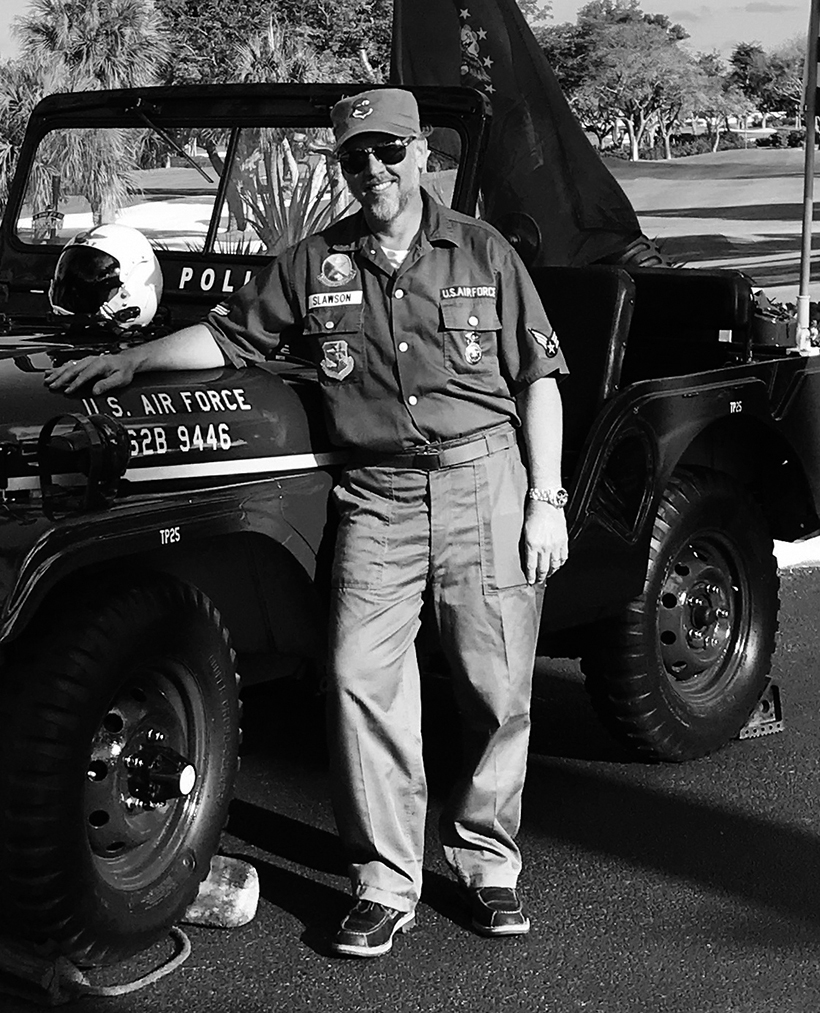
This is me next to the Jeep. The photo was taken by a friend at a USO costume party. We parked a couple of Jeeps at the entrance and greeted visitors. I’m wearing what my father would have worn at Homestead Air Force Base in Miami, during the Cuban Missile Crisis, minus the gun belt.
The restoration
After I bought the Jeep, I discovered, beneath layers of old paint, that it was actually an Air Force Vehicle. That ultimately led me to the decision to replicate that guise. Also, having something different than the normal OD green helped push me in that route as well. One of my goals was to make the jeep a show-stopper for parades and displays, but I didn’t want to replace anything original unless something broke. I wanted the vehicle to stay as original as possible.
I restored it in phases. When things did break, I would replace them, and keep replacing parts until the mechanical issues stopped. We also had to repair an engine with a blown head gasket, a rag inside the cam cover, and replace the peanut butter-looking oil. With no manual to help, most of the energy was spent on trial and error during the restoration.

This was the first parade the vehicle was in, after being painted. The engine wasn’t running, but the passengers were fine being towed. We decorated my pick-up as well, so the Jeep acted as a parade float. This was first use of hats that I bring along, as well.
We removed a ton of OD green overspray paint from the original, black leather seats. The bottom of the seats and the rear seats, as a whole, needed to be replaced. We kept the original Cooper tyres, but the spare tyre is a replacement. The paint and body shop did an incredible job of bringing the custom variation of the classic SAC ‘50s-era Strata Blue.
One thing that I struggled with was the original Strata Blue had a very dull colour in the shade. So, we custom-tweaked the colour so that it kept a strong, deep blue under all lighting conditions. But when in the sunlight, the Strata Blue really popped. They were able to create a beautiful exterior finish, and keep the interior cab area as original as possible.
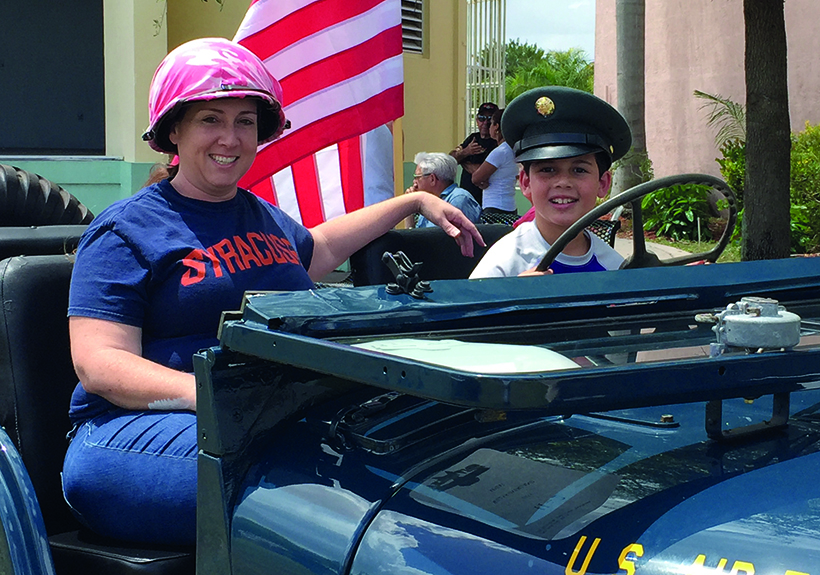
Taken at a past car show event in Homestead. That was my sister and nephew enjoying a photo opportunity with the helmets and hats I would share.
I added the yellow pin stripe to reflect the look of the Homestead Air Force Base’s pin-striping on all its gloss Strata Blue, 1960s vehicles. I also decided to keep the engine unrestored. It’s my delight to see spectators watch the old engine that can start and run. Most people think it’s a newer Jeep until they see under the hood. But the traces of the original yellow, green and Strata Blue paint allow me to educate the onlookers about the true historic significance of this vehicle.
Maybe someday I’ll restore the engine, but it’s so much fun for now to see people’s reaction to what is basically a historic piece of mechanical engineering from another time.

This was taken during a local 4th of July parade event. The parade finished and then we parked the vehicles at a local South Florida park to enjoy additional city events.
Fun to use
One of the greatest things about this project is seeing the many people respond to the Jeep. A lot of research went into getting it as close to the SAC, late 1950s Cold War period as possible, even down to the gloss finish. I’m often getting responses from veterans who come up to me and say: “You nailed it!” The unique look also attracts families and kids who want to hop in and take photos. I don’t mind when people pile on it for photo opps!
I started acquiring different helmets, hats and other military apparel for the kids and families to wear at the events. It’s cool to see the joy on their faces when they look at the photos they’ve taken. One time, I had 12 excited kids pile in for a group photo!
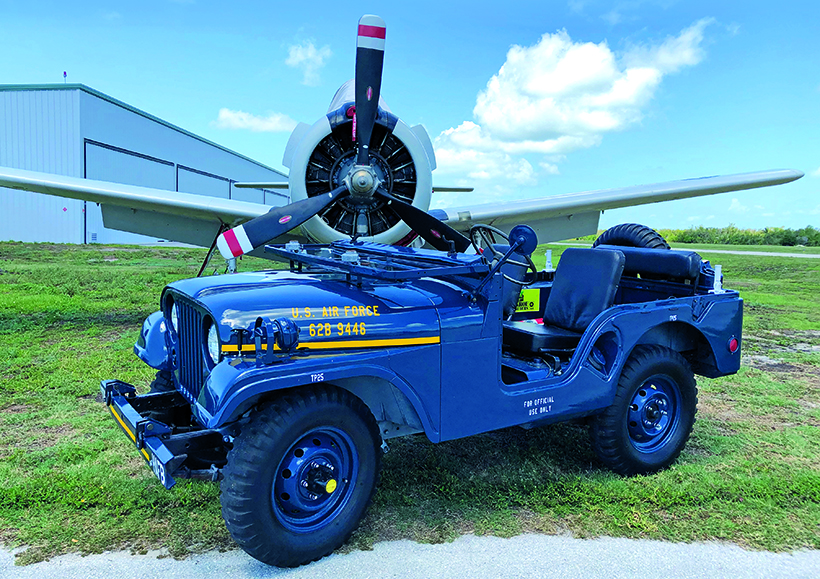
It was great to get the chance to photograph the Jeep in front of this Korean War-era plane, at the Marathon International Airport, in the Florida Keys.
My wife and boys also enjoy taking rides in it around our neighbourhood, and there are always admirers waving to us when we’re cruisin’ by. My father, who served during the Cuban Missile Crisis at the Homestead Air Force Base, was very proud that I used and dedicated his squadron’s numbers from his service time at the base.
What started as a goal to restore this Jeep to its 1950s, active-duty glory, has blossomed into a mission to educate those who come across the Jeep, whether it be in person or on social media. To hopefully spark a lifelong interest in military memorabilia, vehicles or even just collecting, and learning more about our military history and that from around the rest of the world.
For a money-saving subscription to Heritage Commercials magazine, simply click here



